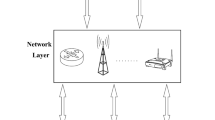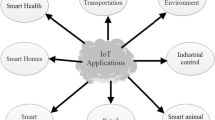Abstract
The wireless sensor networks (WSN) research is emerging fast in the areas of agriculture, industry, smart grid communication, smart monitoring, and smart metering. The Zigbee is a wireless network protocol under IEEE 802.15.4 standard, that provides low cost, low power, and lesser delay in data communication over a PAN network. Several sensor nodes are deployed in WSN geospatial domain to communicate with each other. The sensor nodes are the embedded devices used to perform specific applications by sending information in the network through the coordinator node. The coordinator gathers the data, stores into memory, processes it, and route it to the destination node. The Zigbee protocol supports peer-to-peer, star, mesh and cluster tree topology. In the research paper, the hardware chip design for mesh, star, and cluster Zigbee topology is proposed in which 64 nodes are communicating with each other. The chip simulation is performed on Xilinx ISE 14.7 software for 64-bit internode communication and pre-synthesized on Virtex-5 FPGA. The comparative performance of the chip is analyzed with the help of the FPGA device and timing parameters.












Similar content being viewed by others
Abbreviations
- AoDV:
-
Adhoc on-demand distance vector
- CRC:
-
Cyclic redundancy check
- DSR:
-
Dynamic source routing
- FPGA:
-
Field programmable gate array
- FFD:
-
Full function device
- HDL:
-
Hardware description language
- IEEE:
-
Institute of electrical and electronics engineers
- GHz:
-
Giga herts
- GSM:
-
Global system for mobile
- ISM:
-
Industrial, scientific and medical
- IoB:
-
Input output block
- kB:
-
Kilobyte
- Kbps:
-
Kilo byte per second
- LAN:
-
Local area network
- LUT:
-
Look up table
- LED:
-
Light emitting diode
- MAN:
-
Metropolitan area network
- MAC:
-
Media access control
- Mbps:
-
Mega byte per second
- MHz:
-
Mega hertz
- NoC:
-
Network on chip
- ns:
-
Nano seconds
- PAN:
-
Personal area network
- PDR:
-
Packet delivery ratio
- RFD:
-
Reduced function device
- RTL:
-
Register transfer level
- SMS:
-
Short message service
- QPSK:
-
Quadrature phase shift keying
- VHDL:
-
Very high-speed integrated circuit hardware description language
- WSN:
-
Wireless sensor networks
- WAN:
-
Wide area network
- WPAN:
-
Wireless personal area network
References
Ahmad, R., Sidek, O., Hassin, W. M. H. W., Mohd, S. K. K., & Husain, A. S. (2011). Verilog-based design and implementation of digital transmitter for Zigbee applications. International Journal of Emerging Sciences, 1(4), 723–735.
Ahmad, A. W., Jan, N., Iqbal, S., & Lee, C. (2011). Implementation of ZigBee-GSM based home security monitoring and remote-control system. In 2011 IEEE 54th International Midwest Symposium on Circuits and Systems (MWSCAS) (pp. 1–4). IEEE.
Buthelezi, B. E., Mphahlele, M. I., Du Plessis, D., Maswikaneng, S., & Mathonsi, T. E. (2018). A New Tree Routing Protocol for ZigBee Healthcare Monitoring Systems. In 2018 International Conference on Intelligent and Innovative Computing Applications (ICONIC) (pp. 1–6). IEEE.
Deep, V., & Elarabi, T. (2017). Efficient IEEE 802.15. 4 ZigBee standard hardware design for IoT applications. In 2017 International Conference on Signals and Systems (ICSigSys) (pp. 261–265). IEEE.
Feng, X., Yan, F., & Liu, X. (2019). Study of wireless communication technologies on internet of things for precision agriculture. Wireless Personal Communications, 108, 1785–1802.
Garg, A. (2014). Review of wireless local area network (WLAN) standards and wireless sensor networks. International Journal of Enhanced Research in Science Technology and Engineering, 3, 115–121.
Kim, T., Kim, S. H., & Kim, D. (2018). Distributed topology construction in ZigBee wireless networks. Wireless Personal Communications, 103(3), 2213–2227.
Kumar, A., Sharma, P., Gupta, M. K., & Kumar, R. (2018). Machine learning based resource utilization and pre-estimation for network on chip (NoC) communication. Wireless Personal Communications, 102(3), 2211–2231.
Lee, B. G., & Choi, S. (2008). Broadband Wireless Access and Local Networks: Mobile WiMAX and WiFi. Norwood: Artech House.
Li, S., Li, W., & Zhu, J. (2009). A novel ZigBee based high speed Ad Hoc communication network. In 2009 IEEE International Conference on Network Infrastructure and Digital Content (pp. 903–907). IEEE.
Misra, S., Goswami, S., Taneja, C., & Mukherjee, A. (2016). Design and implementation analysis of a public key infrastructure-enabled security framework for ZigBee sensor networks. International Journal of Communication Systems, 29(13), 1992–2014.
Moridi, M. A., Kawamura, Y., Sharifzadeh, M., Chanda, E. K., Wagner, M., & Okawa, H. (2018). Performance analysis of ZigBee network topologies for underground space monitoring and communication systems. Tunnelling and Underground Space Technology, 71, 201–209.
Nath, S. K., Aznabi, S., Islam, N. T., Faridi, A., & Qarony, W. (2017). Investigation and performance analysis of some implemented features of the ZigBee protocol and IEEE 802.15.4 mac specification. International Journal of Online Engineering, 13(1), 14–27.
Ompal, Mishra, V. M., Kumar, A. (2017). Computer networks and IEEE wireless LAN standards. Journal of Engineering and Applied Sciences, 12, 5584–5589.
Rao, P. M., Rao, Y. C., & Kumar, M. A. (2018, January). Performance analysis of ZigBee wireless sensor networks using Riverbed simulation modeler. In 2018 2nd International Conference on Inventive Systems and Control (ICISC) (pp. 1272–1277). IEEE.
Rao, V. P. (2005). The simulative investigation of Zigbee/IEEE 802.15.4. Master Thesis (M.Sc.). Dresden University of Technology. Retrieved September 10, 2018, from http://www.vaddina.com/images/ZIGBEE_zigbee.pdf.
Soijoyo, S., & Ashari, A. (2017). Analysis of Zigbee data transmission on wireless sensor network topology. International Journal of Advanced Computer Science and Application, 8, 145–151.
Shi, G., & Li, K. (2017). Fundamentals of ZigBee and WIFI. Signal Interference in WiFi and ZigBee Networks (pp. 9–27). Cham: Springer.
Tanenbaum, A. S., Gamage, C., & Crispo, B. (2006). Taking sensor networks from the lab to the jungle. Computer, 39(8), 98–100.
Varghese, S. G., Kurian, C. P., George, V. I., John, A., Nayak, V., & Upadhyay, A. (2019). Comparative study of ZigBee topologies for IoT-based lighting automation. IET Wireless Sensor Systems, 9, 201–207.
Funding
This research received no external funding.
Author information
Authors and Affiliations
Corresponding author
Ethics declarations
Conflict of interest
The authors declare no conflict of interest.
Additional information
Publisher's Note
Springer Nature remains neutral with regard to jurisdictional claims in published maps and institutional affiliations.
Rights and permissions
About this article
Cite this article
Ompal, Mishra, V.M. & Kumar, A. Zigbee Internode Communication and FPGA Synthesis Using Mesh, Star and Cluster Tree Topological Chip. Wireless Pers Commun 119, 1321–1339 (2021). https://doi.org/10.1007/s11277-021-08282-w
Accepted:
Published:
Issue Date:
DOI: https://doi.org/10.1007/s11277-021-08282-w




